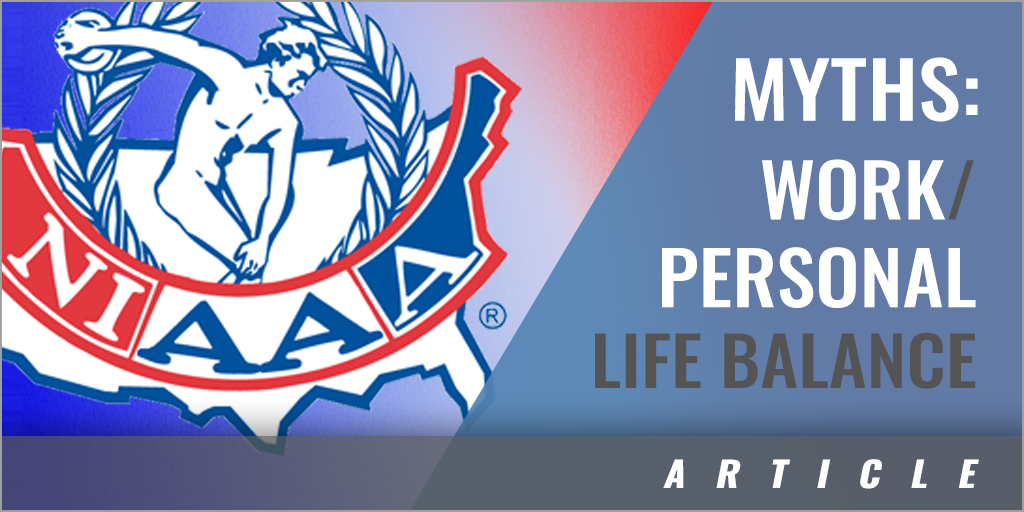|
By: Cole Kanyer, CMAA - Ellensburg HS (WA) and Lauren McDaniel, CAA - Central Kitsap School District (WA) The profession of athletic administration is seemingly losing quality people at an alarming rate, and we must confront the issue of burnout before it causes more career changes, or other, more catastrophic, results. World-renowned speaker and bestselling author, Jon Gordon, stated that, "People don't burnout because of what they do, but because they forget why they do it." Many of us have experienced the misfortune of losing a colleague as a result of the stressors that accompany us in our line of work. It is of paramount importance for us to retain quality people and provide essential tools to maintain wellness in all areas of our lives. To keep retaining quality athletic directors, it is important to address the myths and realities of work and personal life balance for athletic administrators. Moreover, we want to provide ideas which, if implemented, can be used to maintain wellness and increase the longevity of an athletic administrator. Burnout First, we must explore what might lead to burnout. As many as one in three athletic directors will be in a different role next year due to the demands and stressors of the job. There are many factors that go into this: long hours, unsupportive administration, unsupportive or combative parents, challenges in funding and financial support, insufficient compensation, additional roles and responsibilities on top of athletics, and having trouble making time for family or life outside of our profession. There are strategies that can be utilized to alleviate or at least reduce the stressors that lead to potential burnout. These strategies allow us to achieve wellness inside and outside of the workspace, maximizing your health in work and in life. A main theme in developing these strategies is developing the awareness of and ability to work through some stereotypical myths of being an athletic director. Myth #1: Work and personal life oppose each other The first myth is work and life are in opposition to one another. Speaker and author Simon Sinek beautifully articulates this point and stated, "Balance is achieved with two opposing forces, and why should work and life be in opposition?" Instead of viewing these as two distinctly separate areas, work and life should be viewed as integrative, and a mindset shift to "work and life integration" can be achieved. Zenefits author, Cinnamon Janzer, explains work life integration as a more harmonious experience. She said, "Work/life balance places a hard division between work and personal life while work life integration involves a blurred and blended approach to meeting the demands of daily life." Myth #2: You don't have a choice The second myth is the concept of choice. Choice can either be a fact or an illusion based upon the application of the word. For example, if my number one priority is my family but the majority of my time, effort, and energy is devoted to the workplace, I am deciding to invest my time at work instead of home which demonstrates that work is actually my primary priority. In his book "It Takes What It Takes," Mental Conditioning Coach Trevor Moawad talks about the "illusion of choice" and how when you are committed to a goal – or a priority as it relates to this conversation - all you have is the reality of your decisions to get you there because "it takes what it takes." He goes on to share a story about speaking to the college football team at the University of Alabama. Moawad stated, "I would hold a bag of Doritos in one hand and an apple in the other and ask ‘do you really need a nutritionist to tell you which one of these is better for you?'" The undisguised metaphor here is clearly that if you're trying to eat for wellness and peak performance, the Doritos shouldn't even be a choice! Ultimately, your decisions are your active demonstration of your priorities. If those decisions don't align with one's personal identified priorities, that person may be more susceptible to burnout or behaviors that do not positively contribute to overall wellness. Myth #3: You are alone Myth number three is you are on your own. It is extremely easy to fall into the trap of self-pity and viewing yourself as being on an island, but there are people nearby who want to help. Whether it is fellow athletic administrators, or school support personnel, there is always someone who is willing to contribute to the success of you and your programs. The inherent reason that most kids try out for sports is the same reason there are people who want to help: an opportunity to be part of something bigger than themselves. You might have a future athletic administrator in your midst who is seeking a leadership opportunity. Or there may be a teacher in your building craving an opportunity to be around students outside of the classroom environment. Ultimately, if you market your program effectively and highlight the positives to those around you, there will be more help and support in your role. With that being said, if you are in a situation where you are not supported, nobody wants to help, and you're battling many of the aforementioned signs of burnout, you may be in the wrong place. Myth #4: Athletic directors are always available The fourth myth we will identify today is that you are always on duty. While you evaluate your current situation, priorities, and choices, the domain of boundaries must be part of your evaluation. We are not, and cannot be, always on duty. Boundaries must be set, and systems must be established to be in place when the athletic administrator is not on duty. Through technological tools, many areas of our job have become much easier. Scheduling, evaluations, communication, and marketing tools are extremely helpful to the execution of the athletic director's duties. However, our mobile devices offer the chance to keep us on duty through social media, text messages, and phone calls. As a result, intentional efforts must be made to disconnect when necessary and you must rely on the systems you've put in place while you are off duty. Those systems should include any or all of the following:
Myth #5: Work and life balance can't exist The last myth that we will address today is that work/life balance doesn't exist. Many salaried school district employees find themselves on-call most of the time from September through June. Whether or not the on-call status of an athletic administrator is clearly defined or not, it is imperative to invert the idea of "work/life balance" and instead focus on "work/life integration." In her article in CO, a website for the US Chamber of Commerce, Danielle Fallon-O'Leary clarifies the idea of work/life integration and stated, "The largest advantage of work-life integration is flexibility. When employees are able to properly coordinate their schedules and responsibilities, they are more likely to experience satisfaction in all areas of their life." Finding ourselves dangerously close to burnout as athletic administrators, we have found that the keys to work life integration can be successful in three steps. First, one must identify their priorities and involve those priorities in their work when appropriate. Though every day can't be a bring-your-kid-to-workday, your kids can be involved in multiple ways during after school time through game management duties, or through observing their mom or dad achieving great work for others. Step two is a process of communicating, advocating, and establishing flexible time when working long hours. It's not a rite of passage to be the last car in the parking lot after an event. Instead, it's a mind shift. When you find yourself being the last person to leave at night, it is not expected, realistic, or sustainable to always be early to the office the next morning. The last step to moving closer to work life integration is to learn about and maximize the technological tools available to help you. When a person can effectively interact with technology and maintain appropriate technological boundaries, it is amazing how much time you get back. Instead of your time telling you what you need to do, you can now tell your time what you need it to do for you. The formula for burnout in all professions is extremely similar. To combat the factors that contribute to burnout, athletic administrators must not lose focus on why they chose to be involved in education-based athletics. When the "why" is not identified or loses its importance, many of the causes and symptoms of burnout can grow until quality leaders are lost. Through reframing the thought of "work life balance" into the reality of "work life integration" and applying the tools outlined above, athletic administrators can continue to do great work for kids with confidence and satisfaction for years to come. |







